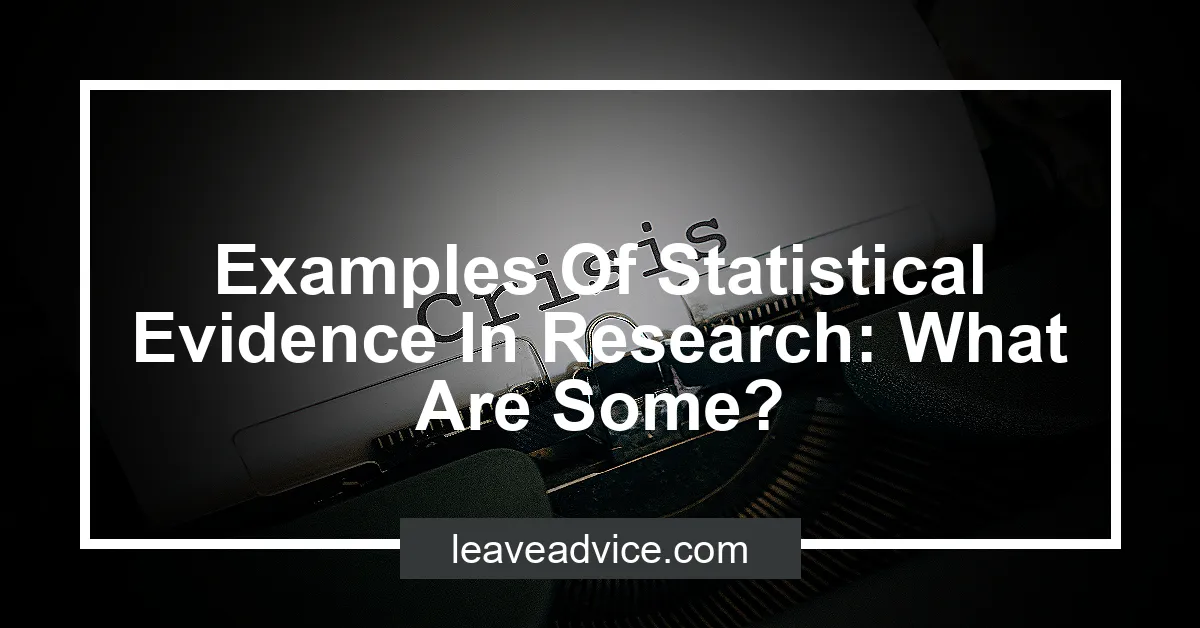Examples Of Statistical Evidence In Research: What Are Some?


Statistical evidence in research refers to a collection of organized and validated observations that support or refute a hypothesis. Examples of statistical evidence in research include experimental, randomized controlled trials, observational studies, and hypothesis testing using statistical data.
Using statistical evidence is important in research as it allows researchers to draw meaningful interpretations, make objective conclusions, and design studies that can be extrapolated to a larger population.
Check out this Youtube video: “What’s the Truth? Understanding Statistics and Evidence …” to gain valuable insights on examples of statistical evidence in research and how to interpret them effectively!
The Role Of Statistical Evidence In Research
Ensuring accuracy and reliability of findings
Statistical evidence plays a crucial role in ensuring the accuracy and reliability of research findings. By employing statistical methods such as hypothesis testing, regression analysis, and measures of central tendency, researchers can validate the robustness of their results.
For example, in a clinical trial, statistical evidence helps determine whether a new drug’s efficacy is statistically significant compared to a placebo, ensuring the reliability of the findings.
Providing a basis for making informed decisions
Moreover, statistical evidence provides a solid foundation for making informed decisions. For instance, in business analytics, statistical techniques like regression analysis and trend analysis enable companies to forecast market trends and customer behavior accurately.
This, in turn, empowers decision-makers to make strategic choices based on data-driven insights, thus reducing the reliance on intuition and subjective judgment.
| Statistical Evidence | Role |
|---|---|
| Hypothesis Testing | Validates findings |
| Regression Analysis | Provides robust insights |
| Measures of Central Tendency | Ensures accuracy |
Types Of Statistical Evidence
Descriptive statistics
Descriptive statistics involve summarizing and describing characteristics of a data set. It provides basic information about variables and highlights potential relationships between them.
For example, measures like mean, median, and mode give a quick overview of the central tendency of a data set, while graphical and pictorial methods visually represent the data, making it easier to identify patterns and trends.
Inferential statistics
Inferential statistics draw conclusions and make predictions about populations based on sample data. This type of statistical evidence is used to infer or generalize from the sample to the population.
For instance, predicting election outcomes based on opinion polls or making inferences about the effectiveness of a new drug based on a clinical trial are applications of inferential statistics.
Correlational statistics
Correlational statistics are used to measure the strength and direction of a relationship between two variables. For example, correlational research can help predict job performance based on test scores, but it does not determine causation.
It’s important to note that correlation does not imply causation and that other factors may be at play.
Experimental statistics
Experimental statistics are used to analyze data from experiments and studies where researchers manipulate variables to observe their effects. This includes hypothesis testing to determine whether there is a significant difference between groups or conditions.
For instance, experimental statistics are commonly used in medical trials to assess the effectiveness of new treatments.
Tables can be used to compare the differences between descriptive, inferential, correlational, and experimental statistics:
| Type | Purpose | Example |
|---|---|---|
| Descriptive Statistics | Summarize and describe data characteristics | Mean, median, mode, bar charts, histograms |
| Inferential Statistics | Draw conclusions about populations | Opinion polls, clinical trials, hypothesis testing |
| Correlational Statistics | Measure relationships between variables | Predicting job performance, analyzing test score data |
| Experimental Statistics | Analyze data from controlled experiments | Medical trials, hypothesis testing in scientific studies |
Examples Of Statistical Evidence In Research
Case studies
- Case studies involve the collection of multiple sources of evidence, including quantitative techniques like questionnaires and audits, as well as qualitative methods such as interviews. For example, a case study on workplace diversity could collect quantitative data on employee demographics and qualitative data from interviews with staff members.
Surveys and questionnaires
- Surveys and questionnaires are vital statistical evidence tools gathering data about people’s preferences or opinions. For instance, a survey on consumer satisfaction with a new product could provide statistical evidence of its success or failure in the market.
Randomized controlled trials
- Randomized controlled trials (RCTs) are prospective studies that measure the effectiveness of a new intervention or treatment. An example could be an RCT evaluating the effectiveness of a new drug in reducing cholesterol levels compared to a placebo.
Observational studies
- Observational studies aim to collect data in a natural environment without any manipulation. For instance, a research study observing the impact of social media usage on mental health would gather statistical evidence on the correlation between the two variables.
Importance Of Statistical Evidence In Validating Research Findings
Statistical evidence plays a crucial role in ensuring the credibility of research results by providing concrete and measurable data to support the findings. It adds an element of objectivity and reliability to the research outcomes, instilling confidence in the accuracy of the conclusions drawn.
Furthermore, statistical evidence provides essential support for research hypotheses and conclusions by demonstrating the significance and impact of the findings. It helps in validating the initial assumptions and theories, offering empirical validation for the proposed hypotheses, and enabling researchers to draw meaningful and well-founded conclusions.
Statistical evidence serves as a cornerstone for establishing the legitimacy and reliability of research findings, offering a strong foundation for making informed decisions and driving meaningful insights in various fields of study.
Common Misconceptions About Statistical Evidence
Misinterpretation of statistical significance
Statistical significance is often misunderstood as an indicator of sample size relevance. However, achieving statistical significance does not render sample size irrelevant.
It is essential to recognize that small differences may not carry substantial meaning, especially when dealing with large datasets. Moreover, statistical significance testing merely evaluates the evidence against a specific hypothesis rather than determining the practical significance of the results.
Confounding variables and biases in research
Confounding variables can mask or falsely demonstrate associations between variables in research, thereby influencing the accuracy of findings. Selection bias and confounding variables present substantial challenges in establishing causal links between treatments and outcomes, necessitating the use of appropriate methodologies to adjust for these factors.
It is crucial to recognize and address confounding variables to ensure the validity of research outcomes.
Inadequate sample sizes leading to unreliable results
Inadequate sample sizes can lead to unreliable research outcomes, particularly when statistical power is compromised. A small sample size may result in a lack of statistical power to address the primary research question effectively, potentially leading to false-negative errors.
Conversely, excessively large samples can raise ethical concerns and may be unnecessary, undermining the efficiency and practicality of the research.
How To Present Statistical Evidence Effectively
Statistics play a crucial role in research, and effective data visualization techniques are essential to convey complex information clearly. Utilizing techniques like pie charts, bar charts, histograms, and heat maps can visually represent data, aiding in pattern identification and distribution analysis.
By incorporating these visualization methods, researchers can enhance the audience’s understanding of statistical evidence.
Data visualization techniques
The use of pie charts provides a visual representation of proportional data, making it easier to showcase relationships and comparisons. Bar charts are effective in displaying comparisons between different groups or categories, while histograms are ideal for portraying distributions of continuous data.
Heat maps offer a compelling visual display of data intensity, contributing to a better understanding of statistical evidence. Selecting the appropriate technique based on the nature of the data and the narrative being conveyed is crucial for a successful presentation.
Properly labeling and explaining statistical charts and graphs
Clear and concise labeling of statistical charts and graphs is paramount in ensuring the audience comprehends the information accurately. Properly labeling axes, utilizing descriptive titles, and incorporating meaningful legends are essential components of effective data presentation.
Additionally, explaining the statistical significance and implications of the visuals aids in providing context, guiding the audience to interpret the findings accurately.
| Visualization Technique | Key Application |
|---|---|
| Pie Chart | Proportional data display |
| Bar Chart | Comparison representation |
| Histogram | Continuous data distribution |
| Heat Map | Intense data visualization |
By mastering data visualization techniques and adhering to proper labeling and explanation practices, researchers can effectively present statistical evidence, ensuring clarity and comprehension among their audience.
Remember, visual storytelling through statistical evidence can transform complex data into a compelling narrative, enhancing audience engagement and understanding.
The Influence Of Statistical Evidence On Policy Making
Statistical evidence has played a pivotal role in shaping policy decisions, notably in public health. For instance, in epidemiology, statistical studies have influenced policies related to workplace safety regulations and public health interventions.
These studies provide concrete data on the impact of job changes on cardiovascular health, guiding the formulation of occupational health policies. Additionally, statistical evidence on the correlation between psychosocial load and job changes has led to the implementation of mental health support programs in various workplaces.
Furthermore, statistical evidence has also influenced policy decisions during public health crises, such as the COVID-19 pandemic. Models based on statistical analyses have guided policymakers in understanding infection patterns, determining the effectiveness of public health interventions, and allocating resources for healthcare facilities.
This empirical data has been instrumental in shaping policies related to social distancing measures, mask mandates, and vaccination distribution strategies, thereby mitigating the spread of the virus and minimizing its impact on public health.
In terms of public opinion, statistical evidence has been utilized to inform the public about the necessity of certain policies. For instance, data-driven campaigns and statistics-based storytelling have been employed to educate communities about the importance of specific policies, garnering public support and shaping favorable opinions.
Additionally, statistical evidence has been crucial in debunking misinformation and conspiracy theories, contributing to a more informed and evidence-based public discourse on policy matters.
| Statistical Evidence Impact on Policy Decisions |
|---|
| Influencing Occupational Health Regulations |
| Guiding Public Health Interventions |
| Shaping COVID-19 Response Measures |
Ethical Considerations In Using Statistical Evidence
Ensuring data privacy and confidentiality is crucial in research to uphold ethical standards. This involves securely storing paper forms containing personal identifying information in locked cabinets and restricting access through licensing agreements.
Additionally, the Principal Investigator holds ultimate responsibility for the integrity of stored data, ensuring privacy protection.
Avoiding misrepresentation and manipulation of statistical data is essential for maintaining ethical statistical practice. Properly organizing and presenting data, collaborating with peers for validation, and asking insightful questions are key strategies to prevent distortion or misinterpretation.
Ethical statistical practitioners must use valid and relevant methodology and data without prejudice, exploitation of vulnerable populations, or unfair outcomes.
| Privacy and Confidentiality | Misrepresentation and Manipulation |
|---|---|
| Securely store paper forms | Properly organize and present data |
| Restrict access through licensing agreements | Collaborate with peers for validation |
| Ultimate responsibility of Principal Investigator | Ask insightful questions to avoid distortion |
Challenges In Using Statistical Evidence In Research
Dealing with missing data
When dealing with missing data in research, one challenge is deciding whether to use imputation or data removal. Imputation involves substituting reasonable guesses for missing data, while data removal omits cases with missing data.
Both methods have their own set of implications and require careful consideration based on the specific research context.
Addressing potential confounding variables
Addressing potential confounding variables in research is crucial to ensure the validity of results. This can be accomplished through strategies such as restriction, matching, statistical control, and randomization.
By carefully accounting for potential confounding variables, researchers can enhance the quality and reliability of their findings.
Interpreting complex statistical analyses for non-experts
Interpreting complex statistical analyses for non-experts poses a significant challenge. It is essential to simplify complex data and use appropriate visualizations to effectively convey the main points.
By choosing the right visualizations and presenting the data in a clear, straightforward manner, researchers can make statistical findings more accessible and comprehensible to non-experts.
The Future Of Statistical Evidence In Research
Advancements in statistical methods and techniques
Statistical methods in research have advanced significantly in recent years, particularly with the availability of generalized linear mixed models in statistical software. These models allow for more accurate data modeling, especially beneficial when dealing with complex and diverse datasets.
The impact of big data on statistical evidence in research
The emergence of big data has revolutionized the landscape of statistical evidence in research. With vast amounts of data at our disposal, researchers are now able to identify intricate patterns and correlations that were previously impossible to uncover.
This has led to a deeper understanding of various phenomena and has significantly enhanced the quality of statistical evidence in research.
Recommended Amazon Products for Statistical Evidence in Research
Here’s a curated list of products that can help you present statistical evidence effectively in research. These recommendations are based on functionality, price, and reviews.
Portable Presentation Clicker


A portable presentation clicker allows for seamless transitions between statistical charts and graphs during research presentations. With wireless connectivity and a user-friendly interface, this tool enhances the effectiveness of delivering statistical evidence.
Pros and Cons of Portable Presentation Clicker
| Pros | Cons |
|---|---|
| Wireless connectivity | Requires batteries |
| User-friendly interface | Costly for basic models |
| Compact and portable | Signal interference in some venues |
Data Visualization Software


Data visualization software provides the capability to create visually compelling charts and graphs. These tools offer various templates and customization options to effectively display statistical evidence for research purposes.
Pros and Cons of Data Visualization Software
| Pros | Cons |
|---|---|
| Versatile chart and graph options | Steeper learning curve for advanced features |
| Customization for branding | Expensive for professional versions |
| Real-time data connectivity | Requires regular software updates |
Digital Voice Recorder


A digital voice recorder is valuable for capturing discussions and interviews related to statistical evidence collection. With features like noise reduction and long battery life, this device ensures accurate data capture during research.
Pros and Cons of Digital Voice Recorder
| Pros | Cons |
|---|---|
| Noise reduction capabilities | Limited storage without additional memory card |
| Long battery life | Small buttons can be challenging to use |
| Easy file transfer to computer | Limited clarity in loud environments |
Laser Printer


A high-quality laser printer is essential for producing professional reports and documentation containing statistical evidence. From crisp text to detailed charts, a laser printer offers superior print quality for research publications.
Pros and Cons of Laser Printer
| Pros | Cons |
|---|---|
| Fast printing speed | Higher initial investment compared to inkjet printers |
| Sharp and clear text and images | Requires toner replacement over time |
| Cost-effective over long-term use | Limited color printing capabilities |
Statistical Analysis Software


The top recommended product for effectively gathering, analyzing, and interpreting statistical evidence for research purposes is the Statistical Analysis Software. This software offers advanced statistical tools for researchers to derive accurate and reliable findings.
Pros and Cons of Statistical Analysis Software
| Pros | Cons |
|---|---|
| Advanced statistical tools | Higher cost for professional versions |
| User-friendly interface | Steeper learning curve for beginners |
| Comprehensive data analysis features | Requires regular software updates |
Ready to improve your statistical evidence presentation? Check out Statistical Analysis Software today for the best results!


Conclusion
Statistical evidence in research can be seen in the form of survey results, such as the percentage of respondents who agreed or disagreed with a certain statement. Additionally, statistical evidence can be found in the analysis of experimental data, such as comparing the means or medians of different groups to determine if there is a significant difference.
Lastly, statistical evidence can also be observed in the presentation of correlation coefficients, which show the strength and direction of relationships between variables.
Furthermore, statistical evidence in research can be demonstrated through the use of confidence intervals, which provide a range of values that are likely to contain the population parameter. Moreover, statistical evidence can be found in the form of regression analysis, where researchers examine the relationship between a dependent variable and one or more independent variables.
These examples illustrate the various ways in which statistical evidence is utilized in research to support or refute hypotheses and make informed conclusions.
Statistical evidence in research plays a crucial role in providing empirical support for research findings. Whether it is through the use of p-values to determine the significance of results or through the construction of frequency distributions to visualize patterns in data, statistical evidence serves as a cornerstone for making informed and evidence-based decisions in research.
By understanding and leveraging statistical evidence, researchers can strengthen the validity and reliability of their findings, ultimately contributing to the advancement of knowledge in their respective fields.












